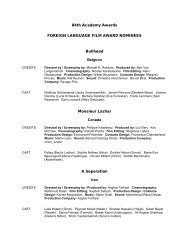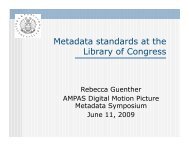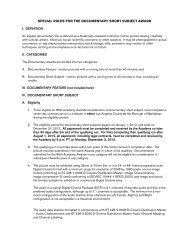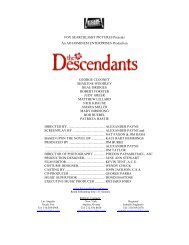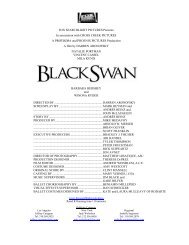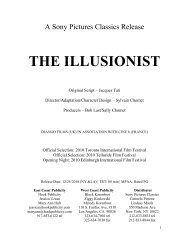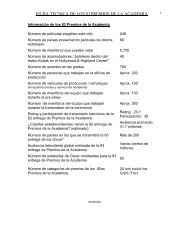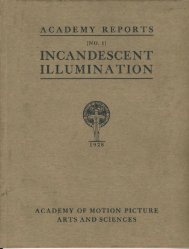Screenwriting - Academy of Motion Picture Arts and Sciences
Screenwriting - Academy of Motion Picture Arts and Sciences
Screenwriting - Academy of Motion Picture Arts and Sciences
Create successful ePaper yourself
Turn your PDF publications into a flip-book with our unique Google optimized e-Paper software.
SCREENWRITING:<br />
THE<br />
LANGUAGE<br />
<strong>of</strong> FILM<br />
Teacher’s<br />
Resource<br />
Guide<br />
© A.M.P.A.S. ®<br />
<strong>Academy</strong> Awards
Dear Educator:<br />
Youth Media International, in cooperation<br />
with the <strong>Academy</strong> <strong>of</strong> <strong>Motion</strong> <strong>Picture</strong> <strong>Arts</strong><br />
<strong>and</strong> <strong>Sciences</strong>, is proud to present the first<br />
in a series <strong>of</strong> annual study guides that will<br />
focus on the different branches <strong>of</strong> the<br />
<strong>Academy</strong>.<br />
This guide focuses on the art <strong>of</strong> writing, one <strong>of</strong> the<br />
many craft areas involved in creating a motion picture.<br />
Students will learn about screenwriting as they complete<br />
the activities in this kit, which has been designed<br />
for students in secondary school English, language arts<br />
<strong>and</strong> communications courses.The activities are<br />
designed to capitalize on students’ natural interest in<br />
current films <strong>and</strong> the excitement generated by the<br />
<strong>Academy</strong> Awards to teach valuable lessons in critical<br />
thinking <strong>and</strong> creative writing, <strong>and</strong> to develop visual<br />
literacy skills.<br />
The <strong>Academy</strong>, organized in 1927, is a pr<strong>of</strong>essional<br />
honorary organization composed <strong>of</strong> more than 6,000<br />
motion picture craftsmen <strong>and</strong> women. Its purposes<br />
include advancing the art <strong>and</strong> science <strong>of</strong> motion pictures;<br />
fostering cooperation among creative leaders for<br />
cultural, educational <strong>and</strong> technological progress; recognizing<br />
outst<strong>and</strong>ing achievements, <strong>and</strong> fostering educational<br />
activities between the pr<strong>of</strong>essional community<br />
<strong>and</strong> the public at large.<strong>Academy</strong> members are the<br />
people who create movies—the cream <strong>of</strong> the industry’s<br />
actors, art directors, cinematographers, costume<br />
designers, directors, film editors, make-up artists, composers,<br />
producers, sound <strong>and</strong> visual effects experts,<br />
<strong>and</strong> writers.<br />
Please share this material with other teachers in<br />
your school.Although the material is copyrighted, you<br />
may make as many photocopies as necessary to meet<br />
your students’ needs.<br />
To ensure that you receive future mailings, please fill<br />
out <strong>and</strong> return the enclosed reply card.Also, feel free<br />
to e-mail us at schoolroom@aol.com to comment<br />
about the program at any time.We welcome your<br />
thoughts <strong>and</strong> suggestions.<br />
Sincerely,<br />
Roberta Nusim<br />
Publisher<br />
This is the first in a series <strong>of</strong> guides that will focus on<br />
different branches <strong>of</strong> the <strong>Academy</strong> <strong>of</strong> <strong>Motion</strong> <strong>Picture</strong><br />
<strong>Arts</strong> <strong>and</strong> <strong>Sciences</strong>. If you would like to receive future<br />
kits from the <strong>Academy</strong> <strong>and</strong> its various branches, please<br />
be sure to fill out <strong>and</strong> return the enclosed reply car<br />
Program Components<br />
1.This instructional guide<br />
2. Four student activity masters<br />
3.A four-color wall poster for classroom display<br />
4.A response card for teacher comments<br />
Target Audience<br />
This program has been designed for students in<br />
secondary school English, language arts <strong>and</strong><br />
communications courses.<br />
Program Objectives<br />
1.To enhance student interest in <strong>and</strong> knowledge about<br />
the motion picture development <strong>and</strong> production process.<br />
2.To encourage students to use critical thinking, creative<br />
writing <strong>and</strong> language skills as they learn how writers<br />
contribute to the process <strong>of</strong> creating a motion picture.<br />
3.To engage students in an exploration <strong>of</strong> film as a<br />
medium <strong>of</strong> communication.<br />
4.To help students become more visually literate.<br />
Introduction<br />
The first <strong>Academy</strong> Awards were h<strong>and</strong>ed out on May 16,<br />
1929, just after the advent <strong>of</strong> “talkies.” By 1930, enthusiasm<br />
was so great that a Los Angeles radio station did a<br />
live, one-hour broadcast, <strong>and</strong> the Awards have enjoyed<br />
broadcast coverage ever since.<br />
The number <strong>and</strong> types <strong>of</strong> awards have grown over<br />
the years. Since 1981,Awards <strong>of</strong> Merit—Oscars—have<br />
been presented for achievement in each <strong>of</strong> the following<br />
categories or sub-divisions <strong>of</strong> categories: acting, art<br />
direction, cinematography, costume design, directing,<br />
documentary film, film editing, foreign-language film,<br />
make-up, music, best picture, animated <strong>and</strong> live-action<br />
short film, sound, sound-effects editing, visual effects <strong>and</strong><br />
writing. In an age when awards shows seem as common<br />
as nightly news programs, the <strong>Academy</strong> Awards are<br />
unique because the judges—<strong>Academy</strong> members—are<br />
the top filmmakers<br />
from around the<br />
world.The question,<br />
“Who gets the<br />
Oscar?,” is decided by<br />
a true jury <strong>of</strong> peers.<br />
With the exception<br />
<strong>of</strong> the best picture,<br />
documentary,<br />
foreign-language film <strong>and</strong> short-film categories, nominations<br />
(<strong>of</strong> up to five selections for each category) are<br />
determined by a secret ballot <strong>of</strong> <strong>Academy</strong> members<br />
representing each category.All <strong>Academy</strong> members vote<br />
to select the final winners.<br />
The awards nomination <strong>and</strong> selection process provides<br />
a wonderful opportunity to teach your students<br />
about the many craft areas—<strong>and</strong> the many communications<br />
techniques—that play a part in creating a motion<br />
picture. Filmmaking is by nature a collaborative process,<br />
with each craft area supporting <strong>and</strong> being supported by<br />
the others. Because our space is limited, this kit focuses<br />
on just one <strong>of</strong> those areas—writing.
Selecting Films<br />
for Student Viewing<br />
Students may select the films they wish to view during<br />
the following activities, or you may wish to suggest<br />
films that you believe are appropriate.<br />
The following films have won <strong>Academy</strong> Awards for<br />
screenwriting <strong>and</strong> may be appropriate for your students:<br />
Forrest Gump (adapted screenplay,<br />
1994), Howards End (adapted<br />
screenplay, 1992), Ghost (original<br />
screenplay, 1990), Dead Poets Society<br />
(original screenplay, 1989), Driving<br />
Miss Daisy (adapted screenplay,<br />
1989), <strong>and</strong> Breaking Away (original<br />
screenplay, 1979).<br />
The following films were nominated<br />
for <strong>Academy</strong> Awards <strong>and</strong> may<br />
be appropriate for your students:<br />
Shine (original screenplay, 1996), Toy<br />
Story (original screenplay, 1995), Babe (adapted screenplay,<br />
1995), Apollo 13 (adapted screenplay, 1995), Field <strong>of</strong><br />
Dreams (adapted screenplay, 1989), <strong>and</strong> E.T. The Extra-<br />
Terrestrial (original screenplay, 1982).<br />
Activity 1.<br />
STRUCTURING<br />
a SCREENPLAY<br />
The creative process <strong>of</strong> writing is the same<br />
regardless <strong>of</strong> the medium—whether the writer is<br />
working on a book, a play or a screenplay. However,<br />
there are important differences in the technical<br />
process <strong>of</strong> writing for a visual medium like film. Perhaps<br />
most important, the writer must be able to<br />
think in visual terms—he or she must be able to<br />
show what is happening.<br />
Syd Field, author <strong>of</strong> several books on screenwriting,<br />
describes a screenplay as being “like a noun—it’s<br />
about a person, or persons, in a place or places, doing<br />
his or her or their ‘thing.’” In a screenplay, the story is<br />
told with pictures, <strong>and</strong> it follows a very definite form.<br />
Like a play, the screenplay unfolds in acts: In act one<br />
the writer sets up the story. Act two contains the<br />
conflict—the basis <strong>of</strong> any drama. According to Field,<br />
“All drama is conflict.Without conflict you have no<br />
character; without character, you have no action;<br />
without action, you have no story; <strong>and</strong> without story,<br />
you have no screenplay.” Finally, act three provides<br />
some kind <strong>of</strong> resolution.<br />
Some writers begin their work by writing the ideas<br />
for their scenes on index cards. Others begin with an<br />
outline. Still others start with a treatment—a narrative<br />
synopsis <strong>of</strong> what happens in the story. Regardless<br />
<strong>of</strong> format, each approach takes into consideration<br />
character descriptions, central story conflicts <strong>and</strong> key<br />
plot points.<br />
In this activity your students will learn about the<br />
structure <strong>of</strong> a screenplay; they will view a film, identify<br />
the three basic parts, <strong>and</strong> analyze how each part contributes<br />
to the dramatic whole.Then, they will develop<br />
the treatment for their own original story.<br />
Supplementary Activity: Have students<br />
identify <strong>and</strong> discuss the “plot points” in the film they<br />
viewed. (A plot point is an incident or event that ties<br />
into the action in the first act <strong>of</strong> the film <strong>and</strong> connects<br />
it to act two.Another plot point occurs at<br />
the end <strong>of</strong> the second act, <strong>and</strong> connects it<br />
to act three.) Have them incorporate plot<br />
points into their treatments.<br />
Activity 2.<br />
FORMATTING<br />
theSCRIPT<br />
The rules for screenwriting extend to<br />
the format in which the script is prepared.The<br />
script section on the activity<br />
sheet provides a good example for your students to<br />
follow (parts <strong>of</strong> it have been abridged for space). For a<br />
more detailed discussion <strong>of</strong> proper script format, you<br />
might want to review the discussion on screenplay<br />
format that is included in the Nicholl Fellowships section<br />
<strong>of</strong> the <strong>Academy</strong> Web site (http://www.oscars.org/<br />
academy/nichollformat2.html).<br />
Be sure to note that “shooting scripts” (the scripts<br />
you are most likely to find at the library) are not the<br />
same as the scripts that screenwriters prepare.These<br />
scripts—known as submission scripts, sales scripts, or<br />
first-draft scripts—do not include scene numbers <strong>and</strong><br />
designate few, if any, camera shots.<br />
Before your students begin to work on their scripts,<br />
you might want to give them some practice in writing<br />
visually. Give your students a situation—for example,<br />
two members <strong>of</strong> the homecoming court show up for<br />
the game in the same dress, or the star forward on the<br />
basketball team does<br />
laundry for the first<br />
time <strong>and</strong> ends up with a<br />
pink jersey.Ask each<br />
student to “script” the<br />
situation.Then, have<br />
your students take<br />
turns explaining the<br />
approaches they took.<br />
Note: If your students<br />
have access to<br />
computers, encourage<br />
them to set up their<br />
scripts according to the model provided. If computers<br />
are not available, students can approximate the format<br />
as they write by h<strong>and</strong>.<br />
Supplementary Activity: Have students<br />
complete their scripts <strong>and</strong> hold a “screenwriter’s<br />
showcase” where each young writer has a chance to<br />
discuss his or her script with classmates.
Activity 3.<br />
DEVELOPING a<br />
SCREENPLAY from<br />
a BOOK<br />
If a book is adapted to film, a screenplay<br />
also must be developed for it.To begin this<br />
activity, have your students view the film<br />
Sense <strong>and</strong> Sensibility—either as a class or<br />
individually at home.Then, have them read<br />
the book.As they read, ask them to make<br />
notes on how the book differs from the film.<br />
The book <strong>and</strong> the film revolve around<br />
Elinor <strong>and</strong> Marianne Dashwood, who with<br />
their younger sister <strong>and</strong> mother are left in<br />
reduced circumstances after the death <strong>of</strong><br />
their father.They are taken in by a kindly cousin, but their<br />
lack <strong>of</strong> fortune affects both young women’s chances for<br />
marriage. Elinor forms an attachment with the wealthy<br />
Edward Ferrars, but his family dispproves.<br />
The exercise on the activity sheet will require you or a<br />
student to read the following passage from the book aloud<br />
to the class. In this passage, Elinor is talking with Lucy<br />
Steele, a wealthy young woman whom she has only recently<br />
met. Elinor speaks first:<br />
“But really, I never understood that you were at<br />
all connected with that family, <strong>and</strong> therefore I am a<br />
little surprised, I confess, at so serious an inquiry into<br />
her character.”<br />
“I dare say you are, <strong>and</strong> I am sure I do not at all<br />
wonder at it. But if I dared tell you all, you would not<br />
be so much surprised. Mrs. Ferrars is certainly nothing<br />
to me at present,—but the time may come—how<br />
soon it will come must depend upon herself—when<br />
we may be very intimately connected.”<br />
She looked down as she said this, amiably bashful,<br />
with only one side glance at her companion to<br />
observe its effect on her.<br />
“Good heavens!” cried Elinor,“what do you mean?<br />
Are you acquainted with Mr. Robert Ferrars? Can you<br />
be_____?” And she did not feel much delighted with<br />
the idea <strong>of</strong> such a sister-in-law.<br />
“No;” replied Lucy,“not to Mr. Robert Ferrars—I<br />
never saw him in my life; but,” fixing her eyes upon<br />
Elinor,“to his elder brother.”<br />
What felt Elinor at that moment? Astonishment,<br />
that would have been as painful as it was strong, had<br />
not an immediate disbelief <strong>of</strong> the assertion attended it.<br />
She turned towards Lucy in silent amazement, unable<br />
to divine the reason or object <strong>of</strong> such a declaration,<br />
<strong>and</strong> though her complexion varied, she stood firm in<br />
incredulity <strong>and</strong> felt in no danger <strong>of</strong> an hysterical fit, or<br />
a swoon.<br />
“You may well be surprised,” continued Lucy;“for<br />
to be sure you could have had no idea <strong>of</strong> it before; for<br />
I dare say he never dropped the smallest hint <strong>of</strong> it to<br />
you or any <strong>of</strong> your family; because it was always meant<br />
to be a great secret, <strong>and</strong> I am sure has been faithfully<br />
kept so by me to this hour. Not a soul <strong>of</strong> all my relations<br />
know <strong>of</strong> it but Anne, <strong>and</strong> I never should have<br />
mentioned it to you, if I had not felt the greatest<br />
dependence in the world upon your secrecy; <strong>and</strong> I<br />
really thought my behaviour in asking so many questions<br />
about Mrs. Ferrars, must seem so odd, that it<br />
ought to be explained.And I do not think Mr. Ferrars<br />
can be displeased, when he knows I<br />
have trusted you, because I know he has<br />
the highest opinion in the world <strong>of</strong> all<br />
your family, <strong>and</strong> looks upon yourself <strong>and</strong><br />
the other Miss Dashwoods, quite as his<br />
own sisters.”—She paused.<br />
Elinor for a few moments remained<br />
silent. Her astonishment at what she<br />
heard was at first too great for words;<br />
but at length forcing herself to speak,<br />
<strong>and</strong> to speak cautiously, she said with a calmness <strong>of</strong><br />
manner, which tolerably well concealed her surprise<br />
<strong>and</strong> solicitude— “May I ask if your engagement is <strong>of</strong><br />
long st<strong>and</strong>ing?”<br />
“We have been engaged these four years.”<br />
“Four years!”<br />
“Yes.”<br />
“I did not know,” said she,“that you were even<br />
acquainted till the other day.”<br />
This passage is very similar to the corresponding scene<br />
in the film. However, Jane Austen tells us a great deal about<br />
what Elinor is thinking <strong>and</strong> feeling. In the film, we must rely<br />
on the writer’s ability <strong>and</strong> the ability <strong>of</strong> the actress who<br />
plays Elinor (Emma Thompson, who also wrote the film’s<br />
Oscar-winning screenplay) to show us what she is thinking<br />
<strong>and</strong> feeling.<br />
Activity 4.<br />
LEARNING from<br />
the WINNERS<br />
Each year, the film industry produces an array <strong>of</strong> outst<strong>and</strong>ing<br />
new releases. Some are especially appropriate<br />
for families, some are appealing to teens, <strong>and</strong> some are<br />
geared toward adult audiences. If you or the parents <strong>of</strong><br />
your students feel that some, or even all, <strong>of</strong> this year’s<br />
nominees might be inappropriate for viewing by young<br />
people, you can modify this activity in several ways. Students<br />
can locate reviews in newspapers <strong>and</strong> magazines,<br />
compare what the critics have to say, <strong>and</strong> determine their<br />
selections for this year’s winning films.They can view <strong>Academy</strong><br />
Award nominees <strong>and</strong> <strong>Academy</strong> Award-winning films<br />
from past years to complete the exercises.A list <strong>of</strong> past<br />
nominees <strong>and</strong> winners appears at the beginning <strong>of</strong> this<br />
teacher’s guide.<br />
ACADEMY OF MOTION PICTURE ARTS AND SCIENCES<br />
Youth Media<br />
International Ltd.<br />
© 1998 YMI Ltd
Activity<br />
1<br />
Reproducible Master<br />
STRUCTURING<br />
a SCREENPLAY<br />
Every good film starts with a good screenplay,<br />
or visual story. Unlike a novel, where the<br />
action unfolds in the mind <strong>of</strong> the main character,<br />
or a play, where the action unfolds through the<br />
words <strong>of</strong> the characters, film is a visual medium.<br />
The viewer must be able to see the action unfold.<br />
The process begins when the writer develops<br />
a “treatment” <strong>of</strong> the story.A treatment is a brief<br />
synopsis that tells the core <strong>of</strong> the story. It is generally<br />
4 to 20 pages in length <strong>and</strong> includes the<br />
plot, action, central characters <strong>and</strong> emotional subplots<br />
<strong>of</strong> the story. It is an excellent tool to allow<br />
the writer to see where story points work, <strong>and</strong> where they do not.<br />
Next, the screenwriter begins to work on the screenplay itself. In doing so, he<br />
or she uses a very specific three-act structure: In the opening act (usually about<br />
30 minutes), the writer sets up the story <strong>and</strong> establishes the relationships<br />
between the characters.Then, there is a second act (usually about 60 minutes),<br />
when the main character must face a series <strong>of</strong> crises or overcome obstacles that<br />
keep him from achieving his goal. Finally, there is a final act (generally about 30<br />
minutes), when the crises or conflicts are resolved.<br />
One page <strong>of</strong> screenplay is equal to about one minute <strong>of</strong> time in the film.That<br />
means the screenwriter must set the story up in about 30 pages, develop the<br />
conflicts or complications in 60 pages, <strong>and</strong> resolve the conflicts <strong>and</strong> tie up the<br />
loose ends in the last 30 pages.<br />
Pick a film that you would like to see.As you watch, try to identify the beginning,<br />
middle, <strong>and</strong> end. Use the space below to make notes.<br />
Title <strong>of</strong> film: ____________________________________________________________________________________________<br />
How is the story set up? How are the characters introduced?<br />
What is the conflict in the film? How does the conflict develop?<br />
_<br />
_<br />
_<br />
_<br />
_<br />
_<br />
_<br />
Now, think about a story that you<br />
would like to tell. Make your rough<br />
notes in the space provided. Use the<br />
other side <strong>of</strong> the paper if you need room.<br />
How will you “set up” the story <strong>and</strong><br />
introduce the characters?<br />
What conflicts will your characters face<br />
as the story unfolds?<br />
_<br />
_<br />
_<br />
_<br />
_<br />
_<br />
_<br />
_<br />
_<br />
_<br />
_<br />
_<br />
How will you resolve the conflicts as you<br />
end your story?<br />
_<br />
_<br />
_<br />
_<br />
_<br />
_<br />
Now you are ready to write a “treatment”<br />
for your story. Use another sheet<br />
<strong>of</strong> paper to write a one-page treatment.<br />
How is the conflict resolved? ______________________________________________<br />
_<br />
_<br />
_<br />
_<br />
© 1998 YMI Ltd
FORMATTING the SCRIPT<br />
There are two kinds<br />
<strong>of</strong> screenplays—<br />
those that are developed<br />
specifically for film, <strong>and</strong><br />
those that are adapted<br />
for film from another<br />
published work. Both<br />
use the same st<strong>and</strong>ard<br />
format, typed in 12-pt.<br />
Courier.<br />
Dialog is centered<br />
on the page in lines <strong>of</strong><br />
about 3 inches.The<br />
characters’ names are<br />
typed in capital letters.<br />
Descriptions <strong>of</strong> how a<br />
character is to speak the<br />
lines <strong>and</strong> what he or she<br />
does as they speak are<br />
enclosed in parentheses.<br />
Scene headings (“slug<br />
lines”) appear in capital<br />
letters. Descriptions <strong>of</strong><br />
settings <strong>and</strong> the action<br />
that takes place are<br />
typed in lines <strong>of</strong> about<br />
6 inches long.<br />
This section <strong>of</strong> the<br />
script for the film, Good<br />
Will Hunting, at right,<br />
shows the correct format<br />
(Good Will Hunting won<br />
the 1997 <strong>Academy</strong> Award<br />
for original screenplay).<br />
Notice how little dialog<br />
each character has at one<br />
time, <strong>and</strong> how much the<br />
characters convey by how<br />
they say their lines <strong>and</strong><br />
what they do. Some dialog<br />
<strong>and</strong> description <strong>of</strong> the<br />
setting has been omitted<br />
where the ** appears.<br />
CUT TO:<br />
INT. SEAN’S OFFICE—DAY<br />
(Sean’s <strong>of</strong>fice is comfortable.** There is a PAINTING on<br />
the wall behind Sean. Sean is seated behind a desk.)**<br />
It is a picture <strong>of</strong> an old sailboat in a tremendous storm—<br />
by no means a masterpiece. Will studies it.)<br />
WILL<br />
You paint this?<br />
SEAN<br />
Yeah. Do you paint?<br />
WILL<br />
No.<br />
SEAN<br />
Crayons?<br />
WILL<br />
This is a real piece <strong>of</strong> s____.<br />
SEAN<br />
Tell me what you really think.<br />
WILL<br />
Poor color composition, lousy use<br />
<strong>of</strong> space. But that s____ doesn’t<br />
really concern me.<br />
SEAN<br />
What does?<br />
WILL<br />
The color here, see how dark it<br />
is? It’s interesting.<br />
SEAN<br />
What is?<br />
WILL<br />
I think you’re one step away from<br />
cutting your ear <strong>of</strong>f. You ever hear<br />
the saying “Any port in a storm”?<br />
<br />
Activity<br />
2<br />
Reproducible Master<br />
Now, watch another film that you would like to see.<br />
Concentrate on the visual elements <strong>of</strong> the story. How much<br />
do you learn about the story from what the characters do? How<br />
much do you learn from what they say?<br />
Title <strong>of</strong> film:______________________________________________<br />
On the back <strong>of</strong> this sheet, briefly explain what the story was<br />
about, describe one or two scenes that you thought were<br />
especially effective <strong>and</strong> explain why.<br />
Now it’s your turn to become a screenwriter.Working from<br />
the treatment you developed in Activity 1, develop the script for<br />
the first 10 minutes <strong>of</strong> your story. Keep in mind that a film is a<br />
visual story <strong>and</strong> that it isn’t necessary to have lots <strong>of</strong> dialog. Each<br />
page <strong>of</strong> your script should equal about one minute <strong>of</strong> screen time.<br />
© 1998 YMI Ltd
Activity<br />
3<br />
Reproducible Master<br />
DEVELOPING a<br />
SCREENPLAY from<br />
a BOOK<br />
While Good Will Hunting was developed from an original screenplay, Sense <strong>and</strong><br />
Sensibility was adapted from the classic novel <strong>of</strong> the same name by Jane Austen.<br />
Adaptations are original works in themselves, but they begin with the previously published<br />
material as their source.Adapting a work can be a challenge because the<br />
writer must not only create a story that is compelling in its own right, but he or she<br />
also must remain true to the original story. Sense <strong>and</strong> Sensibility, which, like Good Will<br />
Hunting, won an <strong>Academy</strong> Award for screenwriting (1995), is a good example <strong>of</strong> a<br />
successful adaptation. It is true enough to Jane Austen’s original story to please readers,<br />
but it also captures viewers who have not read the book.<br />
Compare the scene in the film <strong>and</strong> the passage in the book where Lucy surprises<br />
Elinor with the news that she has been engaged to Edward for four years. How does<br />
the scene in the book differ from the scene in the film?<br />
_<br />
_<br />
_<br />
Pick another film you would like to see that was adapted from a book, play, short story or magazine article. Read the book <strong>and</strong><br />
then watch the film.Then, answer the questions below. Use the back <strong>of</strong> this sheet if you need additional space.<br />
Title <strong>of</strong> original material: ______________________________________________________________________________________________<br />
Title <strong>of</strong> film: ________________________________________________________________________________________________________________________<br />
List three specific ways in which the film <strong>and</strong> the book differed.<br />
• __________________________________________________________________________________________________________________________________<br />
• __________________________________________________________________________________________________________________________________<br />
• __________________________________________________________________________________________________________________________________<br />
Why do you think the screenwriter made the changes he or she did?______________________________________________________<br />
____________________________________________________________________________________________________________________________________________<br />
____________________________________________________________________________________________________________________________________________<br />
Do you think the adaptation was successful? Why or why not?<br />
____________________________________________________________________________________________________________________________________________<br />
____________________________________________________________________________________________________________________________________________<br />
____________________________________________________________________________________________________________________________________________<br />
____________________________________________________________________________________________________________________________________________<br />
© 1998 YMI Ltd
LEARNING from<br />
the WINNERS<br />
In the first three activities, we learned that a good screenplay is a story told with pictures—we see more <strong>of</strong> the story than we<br />
are told in words.We learned that a screenplay has three acts—a beginning, a middle <strong>and</strong> an end.And, we learned that screenplays<br />
can be original works or they can be adapted from previously published material. Now it’s time to look at this year’s nominees.They<br />
will be announced on February 9. List the nominees for each category in the space below.<br />
The nominees for best screenplay<br />
The nominees for best screenplay<br />
based on material previously<br />
written directly for the screen are:<br />
produced or published are:<br />
• __________________________________________________ • ________________________________________________<br />
• __________________________________________________ • ________________________________________________<br />
• __________________________________________________ • ________________________________________________<br />
• __________________________________________________ • ________________________________________________<br />
• __________________________________________________ • ________________________________________________<br />
Pick one film that you would like to see from the list <strong>of</strong> nominees for best adapted<br />
screenplay.After viewing the film, read the book or other source material upon<br />
which it is based.Then, in the space below, tell whether you agree or disagree with the<br />
nomination. (Keep in mind that the nomination is based on the screenplay, not the<br />
source.) How does the screenplay compare to the source? Why do you think the<br />
screenwriter made the changes that he or she did? Do you agree with the changes?<br />
Would you have made other changes? Which version <strong>of</strong> the story did you prefer—the<br />
film or the source material?<br />
_<br />
_<br />
_<br />
_<br />
Activity<br />
4<br />
Reproducible Master<br />
Now, pick one film from the list <strong>of</strong> nominees for best original screenplay.After<br />
viewing the film, describe why you think the nomination was given. How well did<br />
the writer set up the story? Did the writer maintain the tension as the story<br />
unfolded? Did you like the way the story was resolved? If not, how would you have<br />
resolved it differently?<br />
Now, you be the judge. Using what you know about each <strong>of</strong> the nominated films—<br />
either from seeing them or reading about them—predict the winners. Draw a star<br />
by the film in each category that you think will win for best screenwriting.Then,<br />
watch the <strong>Academy</strong> Awards on March 21 or read the paper the following day to<br />
see how you did!<br />
_<br />
_<br />
_<br />
_<br />
_<br />
For more information about the<br />
<strong>Academy</strong> <strong>of</strong> <strong>Motion</strong> <strong>Picture</strong> <strong>Arts</strong> <strong>and</strong><br />
<strong>Sciences</strong>, visit these Web sites:<br />
• http://www.oscars.org<br />
• http://www.oscar.com<br />
Additional Resources<br />
American Cinema: One Hundred Years <strong>of</strong><br />
Filmmaking,Vol. 1, by Jeanine Basinger.<br />
Rizzoli, 1994.<br />
From Script to Screen: Collaborative Art <strong>of</strong><br />
Filmmaking, by Linda Seger <strong>and</strong> Edward<br />
Jay Whitmore. H. Holt & Co., 1994.<br />
Movie Magic:A Behind-the-Scenes Look at<br />
Filmmaking, by Robin Cross. Sterling, 1996.<br />
Screenplay.The Foundations <strong>of</strong> <strong>Screenwriting</strong>,<br />
by Syd Field. Dell Publishing, 1994.<br />
Writing for Film <strong>and</strong> Television, by Stewart<br />
Bronfeld.Touchstone, 1986.<br />
© 1998 YMI Ltd





